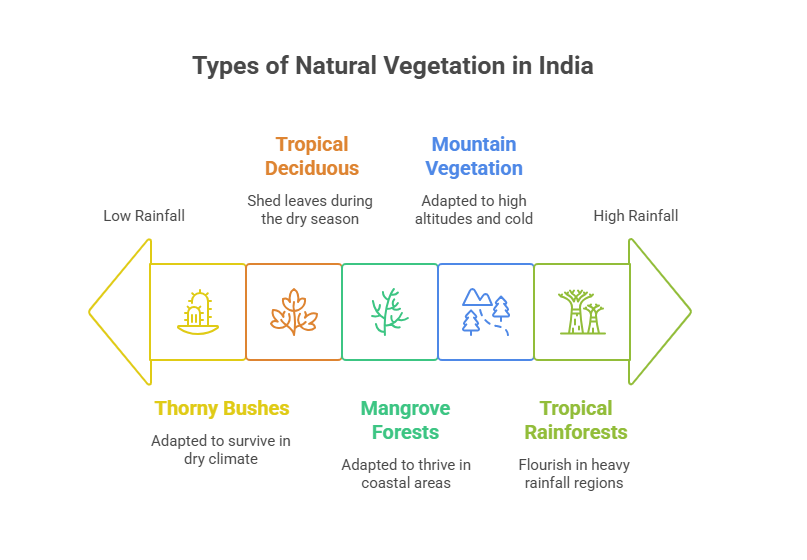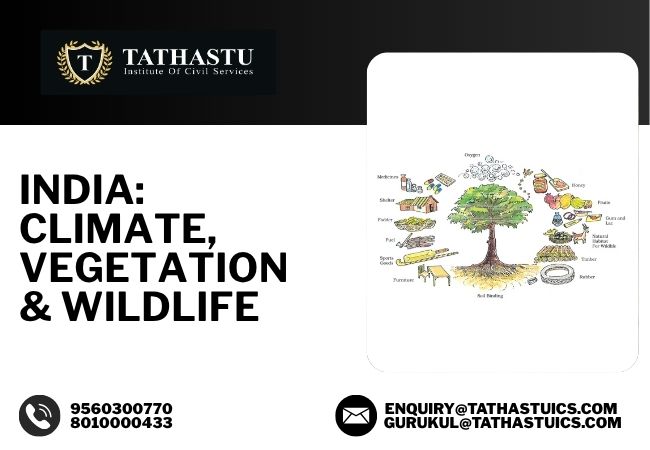India is a land of diverse climatic conditions, rich vegetation, and a wide variety of wildlife. The country’s geographical diversity influences its climate, which in turn affects the natural vegetation and animal life.
Climate of India
- The weather refers to daily atmospheric conditions such as temperature, rainfall, and sunshine, while climate is the average weather conditions observed over many years in a particular area.
- India’s climate is heavily influenced by seasonal winds, thereby it is classified as a monsoon type.
- The major factors affecting the climate include:
- location,
- altitude,
- distance from the sea, and
- relief features.
Four Major Seasons in India
India experiences four major seasons in India:
- Cold Weather Season (Winter) – December to February
- The sun’s rays do not fall directly, leading to low temperatures in northern India.
- Cold and dry winds blow across the region, making the weather chilly.
- Hot Weather Season (Summer) – March to May
- The sun’s rays fall directly on the land, raising temperatures significantly.
- Hot and dry winds, called ‘loo,’ blow during the day, causing dehydration and heat strokes.
- Southwest Monsoon Season (Rainy) – June to September
- Monsoon winds from the Arabian Sea and the Bay of Bengal bring heavy rainfall.
- Mountain barriers cause orographic rainfall in several regions.
- Season of Retreating Monsoon (Autumn) – October to November
- Winds retreat from the mainland back to the Bay of Bengal.
- Tamil Nadu and Andhra Pradesh receive most of their rainfall during this season.

Natural Vegetation in India
Natural vegetation consists of plants that grow without human intervention. India has a wide range of natural vegetation due to varied climatic conditions. Rainfall plays a crucial role in determining the type of vegetation found in different regions.
Types of Natural Vegetation in India
- Tropical Rainforests: These tropical rainforests are majorly found in areas with heavy rainfall, i.e. Western Ghats and Northeastern States.
- These tropical rainforests have dense vegetation, i.e. mahogany, rosewood, and rubber.
- Tropical Deciduous Forests: These tropical deciduous forests shed their leaves in the dry season and cover the entire India.
- These tropical deciduous forests include sal, teak, and neem.
- Thorny Bushes: Thorny bushes are found in regions with low rainfall, i.e. Rajasthan.
- These thorny bushes include cactus, acacia, and date palms.
- Mountain Vegetation: This mountain vegetation is found in the Himalayan regions.
- The mountain vegetation includes pine, fir, and deodar trees.
- Mangrove Forests: These mangrove forests are found in coastal areas, especially in the Sundarbans located in West Bengal.
- It is these forests where the famous Sundari trees grow.

Importance of Forests
- Forests release oxygen and absorb carbon dioxide.
- Forests provide timber, fuelwood, fodder, and medicinal plants.
- Forests prevent soil erosion.
- Forests serve as habitats for wildlife and maintain ecological balance.
| Note: Van Mahotsav is a special afforestation program to promote tree plantation. |
Wildlife in India
India has a rich variety of wildlife, including thousands of species of mammals, reptiles, birds, and insects. The country has established national parks, sanctuaries, and biosphere reserves to protect its wildlife.
Major Wildlife Species in India
- National Animal: The Bengal tiger is found in various parts of India.
- Asiatic Lions: Asiatic lions are found in Gir Forest, Gujarat.
- Elephants: Elephants are found in Assam, Kerala, and Karnataka.
- One-Horned Rhinoceros: One-horned rhinoceros are found in Kaziranga National Park, Assam.
- Camels: Camels are found in the Thar Desert of Rajasthan.
- Snow Leopards and Wild Goats: Snow Leopards are found in the Himalayas Region.
- National Bird: The peacock, along with other birds like parrots, pigeons, and bulbuls.
- Reptiles: Cobras, kraits, and numerous other snake species are found across pan India.
Conservation Efforts
Due to deforestation and poaching, many wildlife species are endangered. The government has initiated several conservation programs:
- Project Tiger: Project Tiger is launched to protect the declining tiger population.
- Project Elephant: Project Elephant aims to conserve elephants and their habitats.
- Wildlife Sanctuaries and National Parks: These are established across India to provide a safe habitat for animals. For example, Ranthambore, Jim Corbett, and Sundarbans National Park.
- Wildlife Week: Wildlife Week is being observed in the first week of October to raise awareness about conservation.
Migratory Birds in India
Several bird species migrate to India during winter, escaping the harsh Arctic cold. Some migratory birds include:
- Pintail Duck
- Curlews
- Flamingos
- Osprey
- Little Stint (weighs only 15 grams, this bird travels over 8000 km from the Arctic region to India).
Conclusion
India’s climate, vegetation, and wildlife are incredibly diverse and play a significant role in maintaining ecological balance. The monsoon plays a crucial role in shaping India’s environment, influencing agriculture and biodiversity. With increasing environmental threats, the conservation of forests and wildlife has become more important than ever. By promoting afforestation and protecting wildlife, we can ensure a sustainable future for generations to come.

